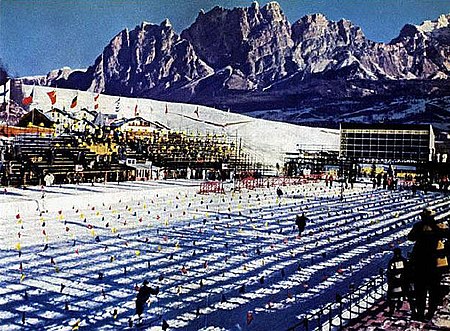Cortina d'Ampezzo (Italian pronunciation: [korˈtiːna damˈpɛttso]; Ladin: Anpezo, Ampëz; historical Austrian German: Hayden) is a town and comune in the heart of the southern (Dolomitic) Alps in the province of Belluno, in the Veneto region of Northern Italy. Situated on the Boite river, in an alpine valley, it is an upscale summer and winter sport resort known for its skiing trails, scenery, accommodation, shops and après-ski scene, and for its jet set and Italian aristocratic crowd.
In the Middle Ages, Ampezzo fell under the jurisdiction of the Patriarchate of Aquileia and of the Holy Roman Empire. In 1420 it was conquered by the Republic of Venice. From 1508, it then spent much of its history under Habsburg rule, briefly undergoing some territorial changes under Napoleon, before being returned to the Austrian Empire (later Austria-Hungary), which held it until 1918. From the nineteenth century, Cortina d'Ampezzo became a notable regional centre for crafts. The local handmade products were appreciated by early British and German holidaymakers as tourism emerged in the late nineteenth century. Among the specializations of the town were crafting wood for furniture, the production of tiled stoves, and iron, copper and glass items.
Today, the local economy thrives on tourism, particularly during the winter season, when the population of the town typically increases from about 7,000 to 40,000. The Basilica Minore dei Santi Filippo e Giacomo was built between 1769 and 1775 on the site of two former thirteenth and sixteenth-century churches; it is home to the parish and the deanery of Cortina d'Ampezzo. The town also contains the Rinaldo Zardini Palaeontology Museum, established in 1975, the Mario Rimoldi Modern Art Museum, and the Regole of Ampezzo Ethnographic Museum.
Although Cortina d'Ampezzo was unable to go ahead with the scheduled 1944 Winter Olympics because of World War II, it hosted the Winter Olympics in 1956 and subsequently a number of world winter-sports events. Cortina d'Ampezzo will host the Winter Olympics for a second time when it co-hosts the 2026 Winter Olympics with Milan. The town is home to SG Cortina, a top league professional ice hockey team, and Cortina d'Ampezzo is also the start and end point of the annual Dolomites Gold Cup Race.
Several films have been shot in the town, most notably The Pink Panther (1963), For Your Eyes Only (1981), and Cliffhanger (1993).







